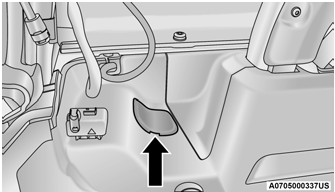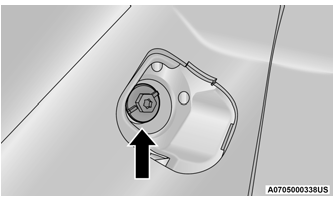Jeep Wrangler: Bulb Replacement / LED Front Fog Lamp
If your vehicle is equipped with LED fog lamps they are replaced as an assembly.
Rear Tail, Stop, Turn Signal, And Backup Lamp
See below steps to replace:
- Remove interior trim panel cap to access
single retaining screw for tail lamp
assembly.

Trim Cap
- Remove retaining screw and disconnect
electrical connector, then remove tail lamp
assembly from the vehicle.
NOTE:
If necessary, push in on the assembly tab located inboard behind the lamp housing.

Retaining Screw
- Remove the three screws from assembly
bracket to access bulb sockets.

Assembly Bracket
- Rotate the appropriate socket a quarter turn counterclockwise, then remove it from the housing.
- Pull the bulb straight from the socket to replace.
Center High Mounted Stop Lamp (CHMSL)
The stop lamp is mounted on a bracket that extends upward from the swing gate behind the spare tire. If service is needed, obtain the LED Assembly from an authorized dealer.
See below steps to replace:
- Remove the spare tire.
- Remove the screws holding the tire carrier cover.
- Remove two screws from lamp assembly and disconnect electrical connector.
License Plate Lamps
See an authorized dealer to replace LED lamps.
NOTE:
To install a new bulb, reverse the procedure above. When installing the new bulb, care should be taken to not allow bare skin to come in contact with the bulb.
 Replacement Bulbs
Replacement Bulbs
NOTE:
See an authorized dealer for LED bulb replacement.
NOTE:
Lens fogging can occur under certain atmospheric
conditions. This will usually clear as
atmospheric conditions change to allow the
condensation to change back into a vapor...
 TIRES
TIRES
..
Other information:
Jeep Wrangler 2018-2025 Owners Manual: Remote Start system
This system uses the key fob to start the engine conveniently from outside the vehicle while still maintaining security. The system has a range of approximately 300 ft (91 m). Remote Start is used to defrost windows in cold weather, and to reach a comfortable climate in all ambient conditions before the driver enters the vehicle...
Jeep Wrangler 2018-2025 Owners Manual: Brake Assist System (BAS)
The BAS is designed to optimize the vehicle’s braking capability during emergency braking maneuvers. The system detects an emergency braking situation by sensing the rate and amount of brake application and then applies optimum pressure to the brakes...
